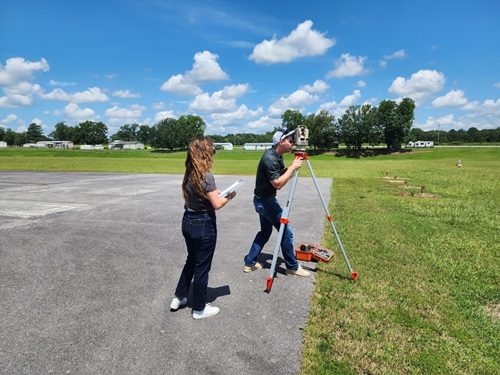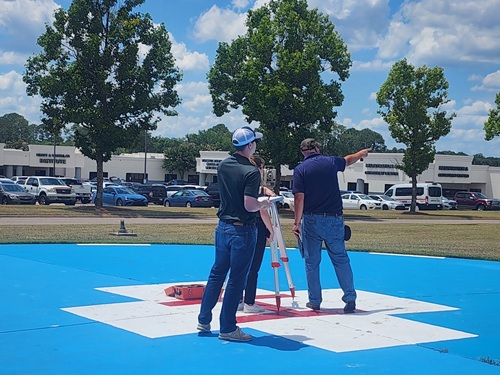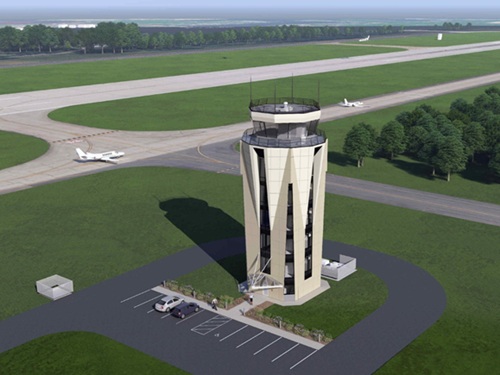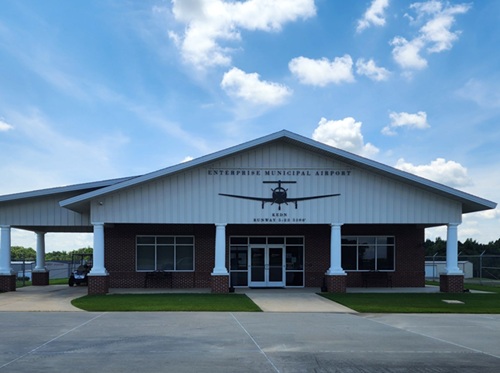As part of its commitment to aviation safety across the state, the Alabama Department of Transportation recently provided a behind-the-scenes look at the airport inspection process overseen by the agency’s Aeronautics Bureau.
[Above photo by the Alabama DOT]
Those routine inspections – showcased recently at the Enterprise Municipal Airport and the Flowers Hospital helipad in Dothan, AL – help keep Alabama’s aviation network safe, reliable, and prepared for both daily and emergency use, the agency said.

Located just minutes from downtown Enterprise, AL, the airport supports regional commerce, agriculture, military-related travel, flight training and medical transport helicopters.
With a single asphalt runway and a growing base of aviation operations, maintaining top safety standards is crucial for this community gateway, explained Mark Bowron, an aeronautics specialist with Alabama DOT.
“Our [airport] inspection looks at runway conditions, pavement markings, lighting systems, taxiways and approach clearances, all key components to ensure pilots and passengers can take off and land safely,” he said in a statement.
Meanwhile, in Dothan, the team visited Flowers Hospital’s helipad, which plays a vital role in medical air transport. Inspectors checked pad conditions, clearances, lighting, and visibility to ensure safe helicopter landings at any hour.

“Hospital helipads like the one at Flowers are lifelines,” noted Bowron. “A safe and compliant helipad can make the difference in a life-or-death emergency. Our job is to make sure it’s always ready.”
Alabama is home to 78 public-use airports, 38 private-use airports, and over 130 hospital and private-use helipads, the agency said – noting that its Aeronautics Bureau works year-round to ensure each facility meets Federal Aviation Administration and state safety guidelines.
“These inspections aren’t just checklists; they’re part of a larger effort to keep Alabama’s skies safe and its communities connected,” Bowron said.
Across the country, state departments of transportation provide support to the aviation sector in a variety of ways.

For example, the Maryland Aviation Administration – a division of the Maryland Department of Transportation – recently held a groundbreaking ceremony for a new air traffic control tower or ATC for Martin State Airport; a civil-military public use airport located roughly 10 miles east of the central business district of Baltimore.
The new ATC will replace the airport’s existing tower, originally built in 1942, to help improve aircraft visibility and accommodate personnel alongside modern air traffic management technologies.
In June, the North Carolina Department of Transportation named the first recipients of a total of $1 million in funding via its Division of Aviation’s new Advanced Air Mobility or AAM planning grant program.
The agency said that funding will support a wide range of planning activities, including transportation needs assessments, land-use and infrastructure planning, multimodal integration strategies, feasibility studies, and policy and regulatory alignment.
In May, the Kansas Department of Transportation recently issued $14.5 million to 47 aviation projects statewide via its Kansas Airport Improvement Program, which provides funding for planning, construction, and rehabilitation of public-use general aviation airports.
Meanwhile, the Utah Department of Transportation recently produced a video explaining how its Division of Aeronautics helps bring pediatric care to rural parts of the state.
And in December 2024, the New Mexico Department of Transportation provided a $1.4 million Rural Air Service Enhancement Grant to the town of Angel Fire to boost tourism and provide better travel options for local residents to the northern New Mexico Mountains.
 States
States
Maine DOT Commissioner Van Note to Retire August 15
August 1, 2025 States
States

